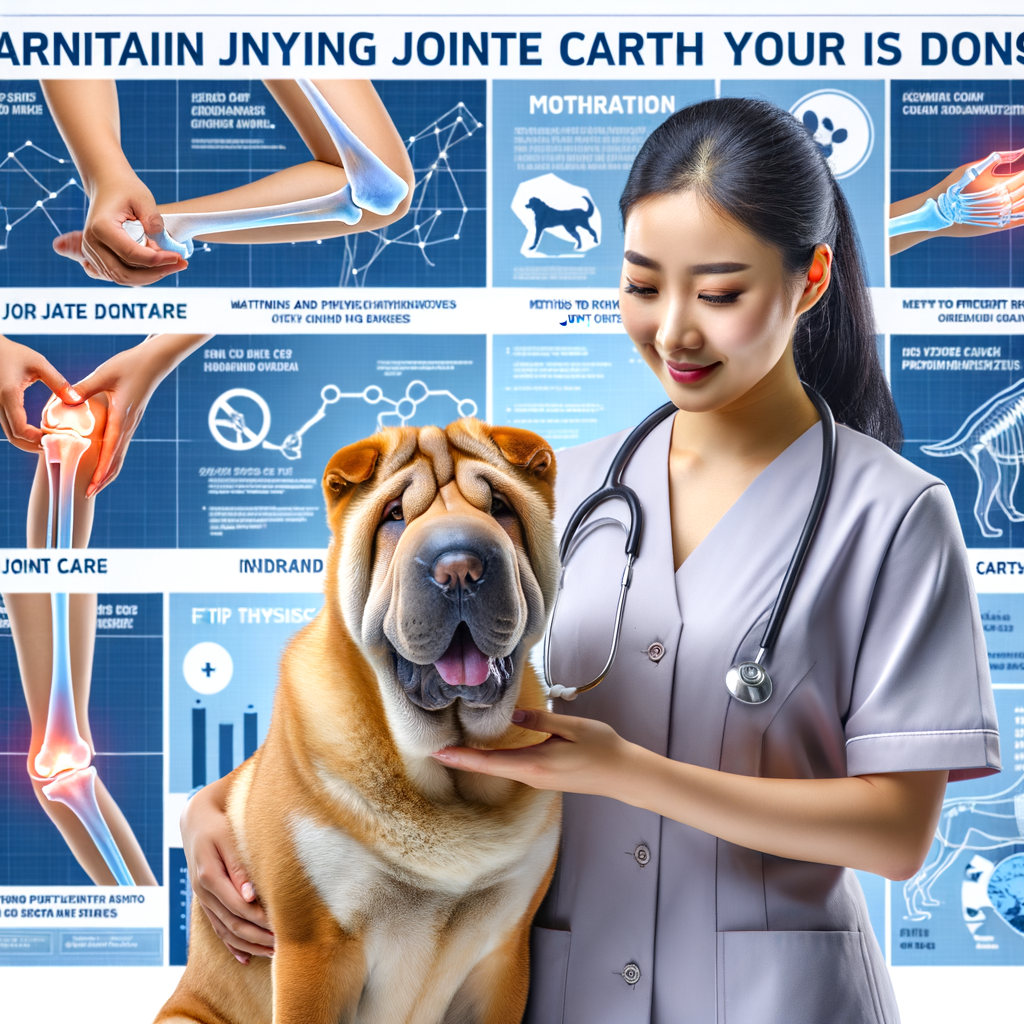
Introduction: The Importance of Joint Health in Shar Peis
When it comes to our beloved Shar Pei dogs, their health is of paramount importance. One aspect of their health that often gets overlooked is joint health. This article will delve into the importance of joint health in Shar Peis and why it’s crucial for their active lifestyle.
- Understanding the Shar Pei breed
The Shar Pei is a breed of dog known for its deep wrinkles and blue-black tongue. Originating from China, these dogs are known for their loyalty, intelligence, and calm demeanor. They are medium-sized, and their compact, muscular build allows them to be quite active. However, due to their unique physical characteristics, they are prone to certain health issues, including joint problems.
- Why joint health is crucial for active Shar Peis
Joint health is essential for all dogs, but it’s especially important for active breeds like the Shar Pei. Healthy joints allow dogs to move freely and comfortably. They can run, jump, play, and engage in all the activities they love without pain or discomfort. However, joint problems can severely limit a dog’s mobility and quality of life.
For Shar Peis, joint health is even more critical. Due to their muscular build and active nature, their joints undergo more stress compared to less active breeds. This makes them more susceptible to joint injuries and diseases like arthritis. Therefore, maintaining good joint health is crucial to ensure your Shar Pei leads a happy, active, and pain-free life.
Understanding Joint Injuries in Dogs
Joint injuries in dogs are a common health issue, particularly in active breeds like the Shar Pei. By understanding the types of joint injuries, you can better protect your furry friend and ensure they lead a healthy, active life.
Common Types of Joint Injuries
There are several types of joint injuries that can affect dogs. Let’s take a closer look at the most common ones:
- Arthritis: Arthritis is a condition that causes inflammation and pain in the joints. It’s common in older dogs, but can also affect younger ones. Symptoms include limping, difficulty moving, and a decrease in activity levels. According to the Arthritis Foundation, one in five dogs will develop arthritis during their lifetime.
- Ligament Injuries: Ligament injuries, such as a torn cruciate ligament, are common in active dogs. These injuries occur when the ligament that stabilizes the knee joint is damaged, often due to sudden twisting movements. A dog with a ligament injury may limp or refuse to put weight on the affected leg.
- Dislocation: A dislocation occurs when a joint is forced out of its normal position. This can happen as a result of a fall or other trauma. A dislocated joint can be extremely painful for your dog and requires immediate veterinary attention.
Understanding these common joint injuries can help you recognize the signs and seek treatment for your dog as soon as possible. In the next section, we’ll discuss the common causes of these injuries and how they can be prevented.
Causes of Joint Injuries in Dogs
Joint injuries in dogs can be caused by a variety of factors. Let’s explore the most common causes:
- Excessive Physical Activity
- Age and Genetic Predisposition
- Obesity
Just like humans, dogs can also suffer from joint injuries due to excessive physical activity. High-intensity activities or repetitive movements can put a lot of strain on a dog’s joints, leading to injuries. For instance, if your dog loves to jump or play fetch for hours, it might be at a higher risk of developing joint issues.
Age is another significant factor that can lead to joint injuries in dogs. As dogs grow older, their joints naturally wear down, making them more prone to injuries. Additionally, some breeds are genetically predisposed to joint issues. For example, large breeds like German Shepherds and Labrador Retrievers are known to have a higher risk of developing hip dysplasia, a common joint disorder in dogs.
Obesity is a serious health issue in dogs that can lead to various problems, including joint injuries. Extra weight puts additional pressure on a dog’s joints, causing them to wear down more quickly. This can lead to painful conditions like arthritis. According to a study, approximately 56% of dogs in the United States are overweight or obese, highlighting the importance of maintaining a healthy weight for your pet’s overall joint health.
In conclusion, excessive physical activity, age, genetic predisposition, and obesity are the main causes of joint injuries in dogs. By understanding these causes, you can take proactive steps to prevent joint injuries and ensure your dog leads a healthy, active life.
Preventing Joint Injuries in Shar Peis
Shar Peis, like all dogs, are susceptible to joint injuries. However, there are ways to prevent these injuries and ensure your pet remains healthy and active. One of the most effective strategies is through proper exercise.
Exercise Tips for Shar Peis
Exercise is crucial for maintaining your Shar Pei’s joint health. However, it’s important to exercise your pet correctly to prevent injuries. Here are some tips:
- Regular, moderate exercise: Regular exercise helps keep your Shar Pei’s joints flexible and strong. Aim for at least 30 minutes of moderate exercise each day. This could include a brisk walk or a game of fetch. Remember, consistency is key.
- Avoiding high-impact activities: High-impact activities like jumping or running on hard surfaces can put a lot of stress on your Shar Pei’s joints. Instead, opt for low-impact activities like swimming or walking on grass or soft ground.
- Importance of warm-ups and cool-downs: Just like humans, dogs need to warm up before exercising and cool down afterwards. A quick five-minute walk before and after exercise can help prevent injuries and keep your Shar Pei’s joints healthy.
Remember, every dog is unique. What works for one Shar Pei may not work for another. Always monitor your dog during exercise and adjust as necessary to prevent injury.
Exercise is just one aspect of preventing joint injuries in Shar Peis. Diet and nutrition also play a crucial role, which we will discuss in the next section.
Diet and Nutrition for Joint Health
Just like humans, dogs need a balanced diet to maintain good health. The right nutrients can help your Shar Pei maintain healthy joints and prevent injuries. Let’s explore some key components of a joint-friendly diet.
- Role of Omega-3 fatty acids
- Importance of maintaining a healthy weight
- Supplements for joint health
Omega-3 fatty acids are essential nutrients that play a crucial role in maintaining joint health. They help reduce inflammation, which can lead to joint pain and stiffness. Foods rich in Omega-3 include fish like salmon and sardines. You can also find Omega-3 in flaxseeds and chia seeds. If your Shar Pei’s diet lacks these foods, consider a high-quality Omega-3 supplement.
Excess weight puts extra pressure on your Shar Pei’s joints, which can lead to injuries and other health problems. Maintaining a healthy weight is essential for joint health. Feed your dog a balanced diet and ensure they get regular exercise. If you’re unsure about your dog’s weight, consult with your vet. They can provide guidance on the right amount of food and exercise for your Shar Pei.
Along with a balanced diet, certain supplements can support joint health in dogs. Glucosamine and chondroitin are popular choices. They help maintain the health of cartilage, the cushioning material within joints. Another beneficial supplement is MSM (Methylsulfonylmethane), which can help reduce joint inflammation and pain. Always consult your vet before starting any new supplement regimen for your dog.
Remember, a healthy diet is just one part of maintaining your Shar Pei’s joint health. Regular exercise, routine vet check-ups, and a loving environment also play a crucial role. By taking a holistic approach, you can help ensure your Shar Pei leads a happy, active life.
Maintaining Joint Health in Active Shar Peis
Keeping your active Shar Pei’s joints healthy is a crucial part of their overall well-being. Regular vet check-ups play a significant role in this process.
Regular Vet Check-ups
Regular vet visits are essential for maintaining your Shar Pei’s joint health. Let’s delve into why these visits are important and what you can expect during a joint health check-up.
- Importance of regular vet visits
- What to expect during a joint health check-up
Regular vet visits are a preventive measure to keep your Shar Pei in the best possible health. These visits allow your vet to monitor your dog’s joint health and detect any potential issues early. Early detection can lead to more effective treatment and can prevent further damage. According to a study, 20% of all dogs will develop some form of arthritis during their lifetime. Regular vet check-ups can help manage this risk in Shar Peis.
During a joint health check-up, your vet will perform a physical examination of your Shar Pei. They will check for signs of discomfort, swelling, or limited movement in the joints. The vet may also perform tests such as X-rays or blood tests to assess the overall health of your dog’s joints. Your vet will then discuss the results with you and suggest any necessary treatments or lifestyle changes.
In conclusion, maintaining your Shar Pei’s joint health requires regular vet check-ups. These visits are crucial for early detection and treatment of potential joint issues. By understanding what to expect during these check-ups, you can better prepare and ensure your Shar Pei remains active and healthy.
Physical Therapy for Shar Peis
Physical therapy is an essential part of maintaining joint health in active Shar Peis. It can provide numerous benefits and there are several exercises specifically designed for this breed.
- Benefits of Physical Therapy
- Common Physical Therapy Exercises for Shar Peis
- Stretching: This helps to improve flexibility and range of motion. It can be as simple as gently moving your dog’s legs in a circular motion.
- Balance Exercises: These can help to strengthen your dog’s core muscles. An example of this is having your dog balance on an unstable surface like a balance ball.
- Walking Uphill: This can help to strengthen the hind legs and improve overall muscle tone. It’s as simple as taking your dog for a walk up a gentle slope.
Physical therapy can greatly improve the quality of life for your Shar Pei. It helps to strengthen their muscles and improve flexibility, which can reduce the risk of joint injuries. It can also help to alleviate pain and discomfort from existing joint issues. According to a study, dogs that underwent physical therapy showed a 60% improvement in their mobility.
There are several exercises that are particularly beneficial for Shar Peis. These include:
Remember, it’s important to consult with a professional before starting any new exercise regimen with your dog. They can provide guidance on the correct techniques and intensity level.
In conclusion, physical therapy can play a vital role in maintaining joint health in active Shar Peis. It offers numerous benefits and there are many exercises that can be easily incorporated into your dog’s daily routine. With the right approach, you can help ensure a healthy, active life for your Shar Pei.
Conclusion: Ensuring a Healthy, Active Life for Your Shar Pei
As we conclude, it’s important to remember that the health and happiness of your Shar Pei largely depend on the state of their joints. By understanding the importance of joint health, recognizing potential injuries, and implementing preventative measures, you can ensure a long, active life for your furry friend.
- Recap of key points on joint health
- Importance of early detection and prevention
Joint health is crucial for your Shar Pei’s mobility and overall quality of life. As we’ve discussed, joint injuries can be caused by a variety of factors, including genetics, diet, and physical activity. Regular exercise, a balanced diet, and routine vet check-ups can significantly contribute to maintaining your dog’s joint health.
Early detection of joint issues can make a significant difference in your Shar Pei’s life. Regular vet visits and being aware of the signs of joint problems, such as limping or difficulty moving, can help catch any issues early. Prevention is also key. By managing your dog’s weight, providing a healthy diet, and ensuring they get regular, low-impact exercise, you can help prevent joint problems before they start.
Remember, your Shar Pei relies on you for their health and wellbeing. By taking these steps, you can ensure they live a happy, active life. After all, a healthy Shar Pei is a happy Shar Pei.














